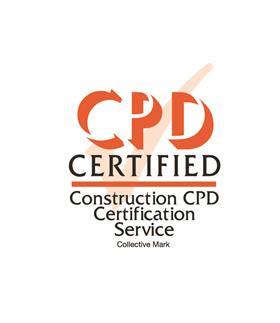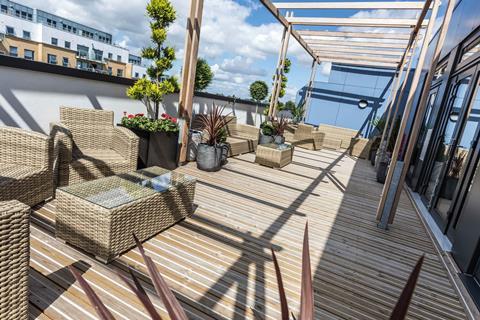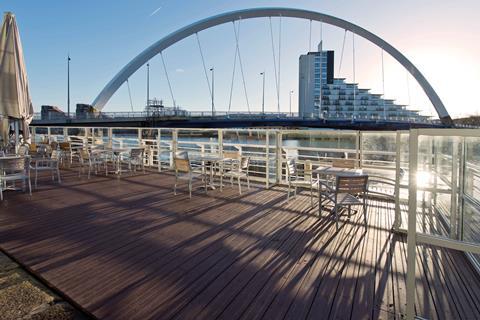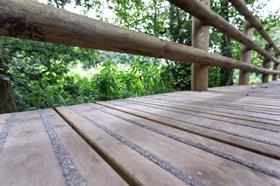This CPD, sponsored by Marley, will look at the benefits of using different types of decking and why timber decking is a sustainable product. It will also explore possible hazards and solutions to consider at planning stage, alongside profile choices

CPD CREDITS: 60 MINUTES
For more information about Assemble Media Group’s CPD distance-learning programme, click here


Introduction
Sustainable softwood timber decking is a versatile material for designing an area and can be used to maximise space. Different decking materials can be applied to a scheme depending on the sort of weather conditions the end result will face. Using this product enables meeting Part M of the Building Regulations and helps projects achieve Disability Discrimination Act compliance. Anti-slip products can provide a low slip potential for any given project as well as providing a low maintenance hard-landscaping material. This CPD will look at types of decking, how sustainable they are, hazards and solutions, and profile choices.
Why use timber decking?
The availability of durable timber with full environmental certification has been a strong reason for its selection on many projects. There are different types of decking available, including softwood, composite, engineered products and hardwood. With correct grading and calculation of load spans, safe, durable designs can be created.
Timber decking as a product has great potential to aid design creativity. It allows areas such as rough terrain, water, slopes and marshland to become accessible and productive.
Decking creates usable space, offering different perspectives and vistas to buildings and surrounding areas. It can help connect the flow from one area to the next, adding definition to building, gardens and public spaces. It stands the test of the rigours of modern day living, inclusivity and today’s green agenda.
Timber frames can be easily constructed to provide access to areas that were not previously accessible via boardwalks, bridges and cycleways. It has often been used for jetties, pontoons and marinas, either installed onto a timber, metal or concrete frame or installed onto floating pontoons. Boards such as these can be supplied cross-cut to the width of the pontoon so that when the boards arrive on site they are ready to install with no wastage.
Timber decking is often useful in schools, either for linking classrooms together, providing a congregation area or an outdoor playing area where lessons can take place in the summer. With the increased popularity of outdoor areas in the leisure market, a timber deck is an ideal option to create a practical and beautiful al fresco dining experience. Anti-slip deck boards should be used as the decks will be used throughout the year, including wet and frosty months.

Types of timber
Hardwood comes from broad-leaved trees such as oak, cherry and teak. Less than one-tenth of timber sold in the UK is hardwood, which is mainly used for high-class joinery. Hardwood is classified as either temperate, found in regions that include Northern Europe and North America (oak, ash, maple) or tropical, which is found in three main continents of Africa, South America and Asia (sapele, iroko, teak).
Typical hardwoods used for timber decks include ipe, cumuru, massaranduba, ekki, balau, and European oak. Some hardwoods are highly resistant to decay and wood-rotting fungi, which makes them extremely durable and avoids the need for preservative treatment. Only species rated as durable should be specified.
Softwood is a more economical option than hardwoods. A variety of softwoods are used in the UK – spruce is a common choice but European redwood is often selected for timber decking. Redwood is chosen both for its appearance and because it absorbs preservative treatment effectively, which increases the durability and the longevity of the boards.
What is modified timber?
Modified timber is exposed to extreme heat, with some examples using chemicals to permanently alter the structure of the cells of the timber to give them new characteristics. These processes improve durability and make the timber more stable and resistant to decay, so a long service life can be achieved. A side effect to being exposed to extreme heat is that they can become brittle and can wear away, especially in areas of high footfall. Modified timbers cannot be structurally graded so care needs to be taken when specifying for commercial projects.
What is WPC decking?
Wood plastic composite (WPC) decking is a relatively new innovation – it has been present in the UK market for around 10 years. Composite decking can be made up of wood fibres and plastic; either mixed or coated wood fibres with a polymer coating. Each product has differing percentages of polyurethane, polypropylene and timber fibres. There are a wide range of colours and use of deck clips is a common fixing method. Composite decking cannot be structurally graded, so care needs to be taken when specifying for commercial projects.
Inclusivity
Designing and using products that are inclusive is a top priority in today’s built environment, coming only behind health and safety. Part M of the Building Regulations covers access and use of buildings – it requires that people, regardless of disability, age or gender are able to gain access to buildings and use their facilities, whether as a visitor, employee or resident.
The Disability Discrimination Act (DDA) 1995 aims to end the discrimination that faces many people with disabilities. A product cannot be DDA compliant, but it can help a project achieve DDA compliance by showing that the use of it takes into consideration peoples’ access to buildings.
Ramps used for inclusive access can be temporary or permanent structures and are easily made from anti-slip deck boards. Anti-slip deck boards can be used anywhere where there is public access, a high level of pedestrian traffic, a high slip risk and for stairs and ramps.

Sustainability
Timber is the only renewable hard landscaping material. In managed forests, five trees are planted for every tree harvested. Trees in the forest absorb carbon dioxide and release oxygen as they are growing. Sustainable forests also provide hundreds of thousands of jobs worldwide, as well being the natural habitat for many species.
The Scandinavian forests where softwood is harvested are extremely well managed. Third-party accreditation schemes visit the mills to ensure that the rules and standards are being adhered to.
Certification schemes
- PEFC – The Programme for the Endorsement of Forest Certification (PEFC) is an international non-profit, non-governmental organisation dedicated to promoting sustainable forest management through independent third-party certification.
- The Forest Stewardship Council (FSC) is an international, non-governmental organisation dedicated to promoting responsible management of the world’s forests.
The PEFC and FSC run the world’s two major certification schemes. Roughly 90% of timber used in the UK comes from certified sustainable sources. Both are highly respected, sought
after in the industry and strictly audited. Both certification schemes give assurances to the purchaser that the timber originates from well-managed forests.
The carbon question
Timber products have the lowest embodied carbon of any mainstream building material, with roughly one tonne of carbon stored for every square metre of timber. The use of sustainably harvested timber creates a much lower carbon footprint than other common building materials.
Research by the Cooperative Research Centre for Greenhouse Accounting showed that more than 25 tonnes of greenhouse gases could be saved if timber products were used to build a family home instead of the common alternatives.
In terms of manufacturing, timber products require far lower energy inputs than the alternatives and there is very little waste. Timber left over from manufacture is used in biomass heating and chipping, and sawdust can also be used for animal bedding.
Standards, performance and installation
There isn’t a specific UK or European standard for exterior decking, but the Timber Decking and Cladding Association (TDCA) has published a guide to best practice covering timber choice through to design and installation.
When fitting timber decking both the joists and the deck boards must be graded. The timber is graded by trained graders looking for issues such as knots, wane and slope of grain which may cause a weakness in the timber. There are two grades for softwood: C16 and C24. C24 is a more demanding grade and the boards are required to contain smaller and fewer knots.
Timber decks in commercial applications are engineered structures with the deck boards taking a load. When laying decking, there are certain standards to apply, particularly concerning loading and deflection. Too much deflection can lead to a trip hazard when one board sinks lower under weight than the board in front of it. This is easily overcome by following the correct span tables. Joists are graded for strength as they will be taking a load and make up the supporting structure to the deck. The reason we grade boards is that although deck boards are unlikely to snap, they can be springy underfoot if joist centres underneath are too wide apart, leading to a potential trip hazard when moving across the boards.
Lastly, there should be “appearance grading” for items such as knots and holes – effectively dead knots – to make the boards more aesthetically appealing.

Treated decking
One of the perceived disadvantages of softwood timber is decay. This can be easily overcome to give excellent longevity and predictability to softwood timber decking.
Timber is vacuum pressure impregnated with preservative, with a 30-year service life achievable for treated softwood.
Treatment classifications:
- Use class 3: external out-of-use ground contact, exposed to the weather;
- Use class 4: in contact with the ground or fresh water or permanently exposed to wetting.
It is very important to ensure that posts and joists placed in or on the ground are treated to use class 4, otherwise the substructure will be subject to rotting. It should be noted that treated timber is not suitable for use in salt water.
Timber decking can be fire treated to reduce the spread of flame. Fire retardant treatments are used by specialist treatment centres under the stringently controlled conditions of European Standard EN 13501 to meet Building Regulations.
Getting the specification right
The Health and Safety Executive (HSE) reports that slips and trips are the most common cause of injury at work. On average, they account for more than one-third of all major injuries and over 40% of all reported injuries to members of the public. HSE statistics suggest that the majority of these accidents are slips, most of which happen when floor surfaces are contaminated (for example by water, frost or algae).

Anti-slip inserts can be added into the timber decking, giving timber a low slip risk even in wet conditions.
To assess the slip resistance of flooring, anti-slip deck boards should be independently tested by the HSE using the Stanley Pendulum Test in accordance with the UK slip resistance test, which provides a PTV rating. The minimum PTV requirement for surfaces to be considered a low slip potential is 36.
It is important to consider every aspect of usage and get expert advice at the planning stage before designing your deck. If a slippery deck can lead to a slip or fall, it means that your decked area can not be used all year round – if someone was to slip there may be the potential of a claim.

Profiles
Outside of the UK, most countries use a flat or smooth board. When walking parallel to the grooves, profiled boards can be more slippery when wet as there is less friction underfoot.
This profile is much more difficult to clean as dirt accumulates in the castellations (or ridges). The accumulated dirt and debris also traps water, so the maintenance and cleaning of the boards is an especially important consideration in areas where food is served. From a practical consideration, castellations can become easily worn from urban footwear such as high heeled shoes, which can result in them being damaged. The castellations are also uncomfortable for wheelchair users when they go over the boards.
A smooth profile is much easier to clean as dirt and debris can be swept away, and provides a more stable surface for tables and chairs in eating areas or private balconies. Smooth profiles are more inclusive for wheelchair users and provide a lower risk of people wearing high heels tripping, which may be a possibility on a castellated deck.

How to take this module
Assemble Media Group’s CPD distance-learning programme is open to anyone seeking to develop their knowledge and skills. Each module also offers members of professional institutions an opportunity to earn between 30 and 90 minutes of credits towards their annual CPD requirement.
This article is accredited by the CPD Certification Service. To earn CPD credits, read the article and then click the link below to complete your details and answer the questions. You will receive your results instantly, and if all the questions are correctly answered, you will be able to download your CPD certificate straight away.
CPD CREDITS: 60 MINUTES
Privacy policy
Information you supply to Assemble Media Group Limited may be used for publication and also to provide you with information about our products or services in the form of direct marketing by email, telephone, fax or post. Information may also be made available to third parties. Assemble Media Group Limited may send updates about Building CPD and other relevant Assemble Media Group Limited products and services. By providing your email address you consent to being contact by email, telephone, fax or post by Assemble Media Group Limited or other third parties. If at any time you no longer wish to receive anything from Assemble Media Group Limited or to have your data made available to third parties, contact the Data Protection Coordinator at building@building.co.uk. View our full privacy policy he




























1 Readers' comment